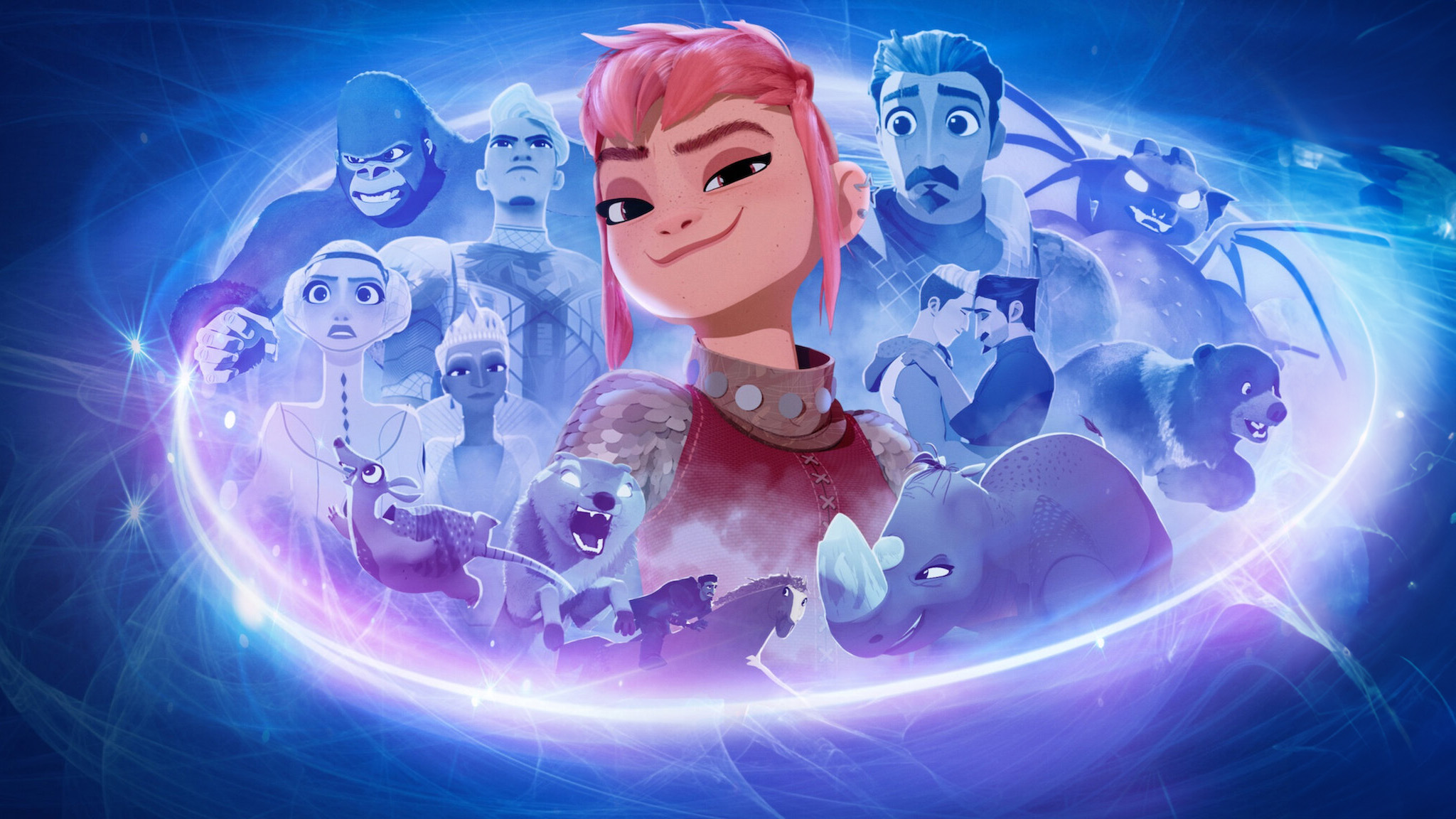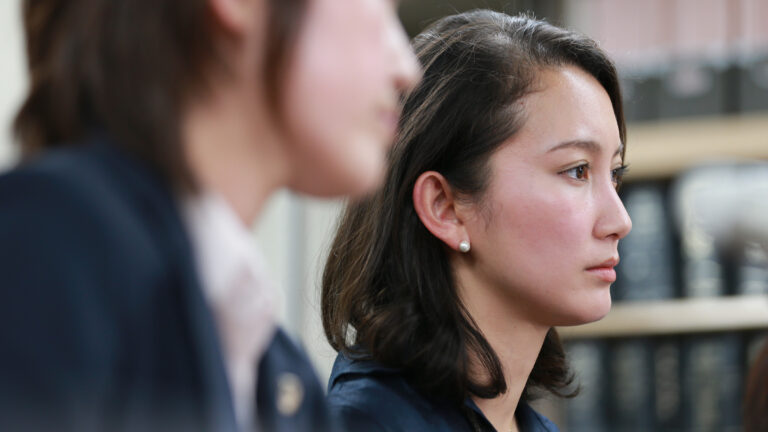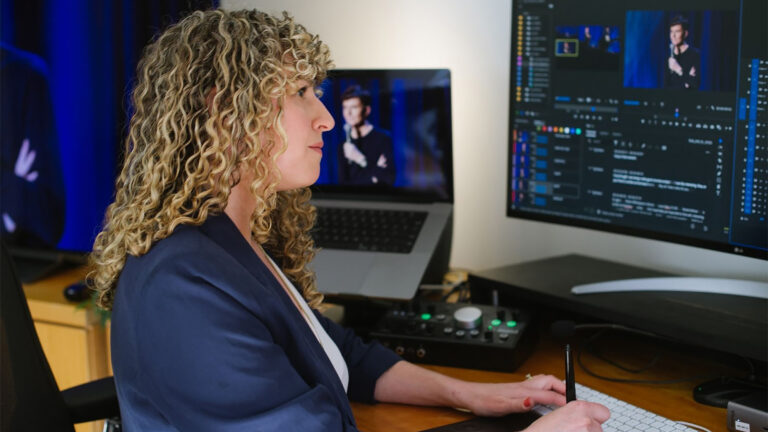Nimona editor, Randy Trager, ACE makes a return trip to The Rough Cut to share the inside story of how his latest film went from dead on the cutting room floor to live and loud on Netflix. Beginning its development life under the banner of Blue Sky studios and its parent company, 21st Century Fox, Nimona and the rest of the Blue Sky team were moved under Disney during their acquisition of Fox.
The film’s rocky development road seemingly ended in April 2021 when Disney shuttered Blue Sky. With her relentless, never-say-die attitude, Nimona found new life again with Annapurna Pictures and Netflix.
Editing Nimona
Join us now as we talk about:
- How to pack and unpack an animated feature,
- Keeping the tone light while keeping it real,
- The virtual future of animation studios,
- Voice over and over and over again,
- And breaking the law with needle drops
Listen while you read…
Matt Feury: The last (and only time) we had a chance to speak was at the end of 2019 for Spies in Disguise. At the time, I don’t think either one of us realized that it would be the last film for Blue Sky, the same studio that brought us Ice Age and Rio.
Blue Sky was owned at the time by Fox and then Disney acquired Fox and as such, acquired Blue Sky. And then in February 2021, Disney shut down Blue Sky. They cited reasons that largely had to do with COVID lockdowns and things like that. But basically, by April 2021, Blue Sky was done. I know it’s not a pleasant memory, but it’s certainly a unique insight into the business.
How did that impact you and the team?
Randy Trager: Disney bought us toward the middle-end of Spies in Disguise, but everything was all systems go at that point and they were supportive. Then when COVID hit it seemed like shaky ground was getting shakier. At that point, Nimona was already going. Nimona has had a long history prior to my being involved. In fact, I think when we were finishing Spies in Disguise, Nimona was already maybe a year or two into its first iteration with a different director.

And just prior to COVID, that director left and they brought on [directors] Nick [Bruno] and Troy [Quane], who directed Spies. Five days later, the studio shut down. So they started working remotely with their editor, Marissa Horowitz, who did a fantastic job, especially since she never even met the guys in person. I was on a development project at the time and they did it remotely and in very short order in terms of animation, they got the movie up on reels. In maybe six months they had a pretty solid version with her leading.
At the time, I think a lot of the other editors were in between projects. So there were maybe six or eight other people helping put together scenes and whatnot. It was a really fast turnaround, which was great because I think it boosted confidence in the project and the new direction it was going in.
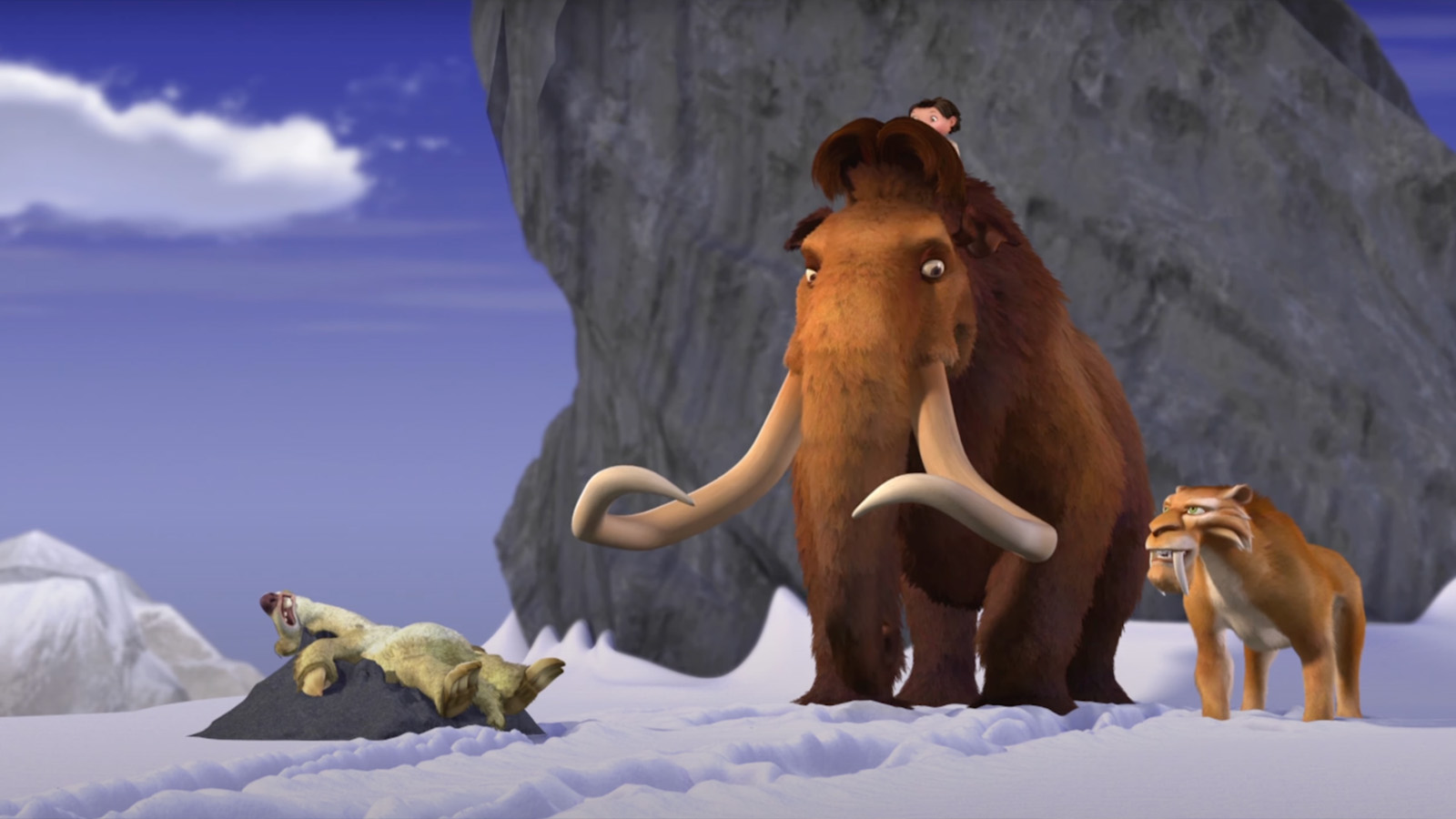
They worked on that for almost a year before they announced the closing. And yeah, that was pretty devastating. I was at the studio for 18 years, which was mind blowing because I had been freelance before that, and that’s how I saw my life going. So I was very lucky to have been there for so long.
MF: Not that the practical part of this is the most important, but just out of curiosity, when the studio got shut down, did everything get archived and packed away? How did the digital and material assets get stored so that ultimately you could bring Nimona back to life?
Randy Trager: Everything did get archived. I believe a lot of it was cloud based, particularly Nimona. A lot of assets were archived, as well, in terms of the rigs for the characters and environments. There were probably a good handful of scenes that were either just starting animation or that had been animated. The rest would have been maybe just entering layout.
The movie’s over…the studio’s closed. This is not going anywhere.
All that material was archived. There wasn’t a plan at that point. We didn’t know what was happening. It was pretty chaotic at the time and a lot of it was going on behind the scenes that most of us weren’t even aware of. It seemed like the movie’s over, you know, the studio’s closed. This is not going anywhere.
And it was kept alive for a while, so it wasn’t like immediately archived. But I think behind the scenes, as it became more of a possibility, efforts were taken to archive and set aside the materials that would be needed to move forward, including a whole storyboard library. The Avid projects were archived and the studio closed. And then it seemed like it was happening with a different studio and that maybe they were going to be able to keep on 200 or 300 people to continue making it at Blue Sky.
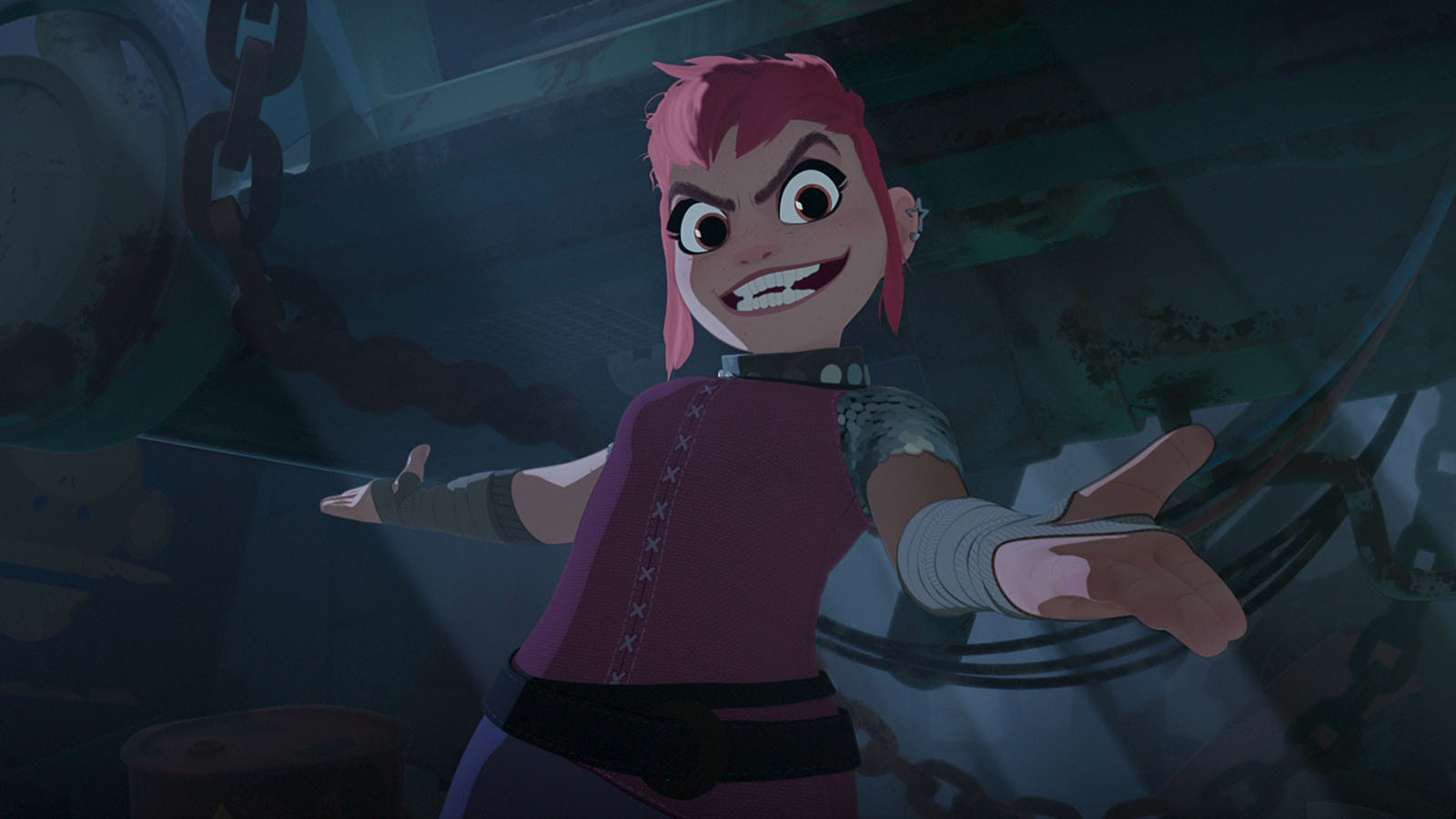
That idea fell apart pretty quickly and it was on again, off again for a few weeks there. It was a bit of a roller coaster where people were really excited. I was at that point asked to come on because Marissa had already moved on. She’s at Pixar now, so I was excited to go from, ‘Oh shit, no job’ to ‘Oh man, great. I get to work with these great people on a project that has such potential.’ So maybe that was over the course of a month where it was uncertain whether or not it was happening or not. Then we got the green light that Annapurna had picked it up and that was incredible.
MF: Thinking about the situation that you went through and the way that you were able to resurrect the film, it kind of begs the question, certainly for animation, do you even need a physical studio anymore? Other than being able to record the actors’ voices somewhere and if you wanted to have an actual orchestra for the score instead of creating it all digitally, it would seem like animation is the medium where you can have a virtual studio.
I mean, as nice as it is to have the team together for creativity and camaraderie, you could easily have a virtual animation studio.
Randy Trager: I personally think so. So there was a core group of us doing the creative, whether it was the producers, the directors and myself, managers, coordinators, etc., that were all working remotely. And we were putting together the reels, and then DNEG was the animation house and they were in London, Montreal, Toronto, and Mumbai.
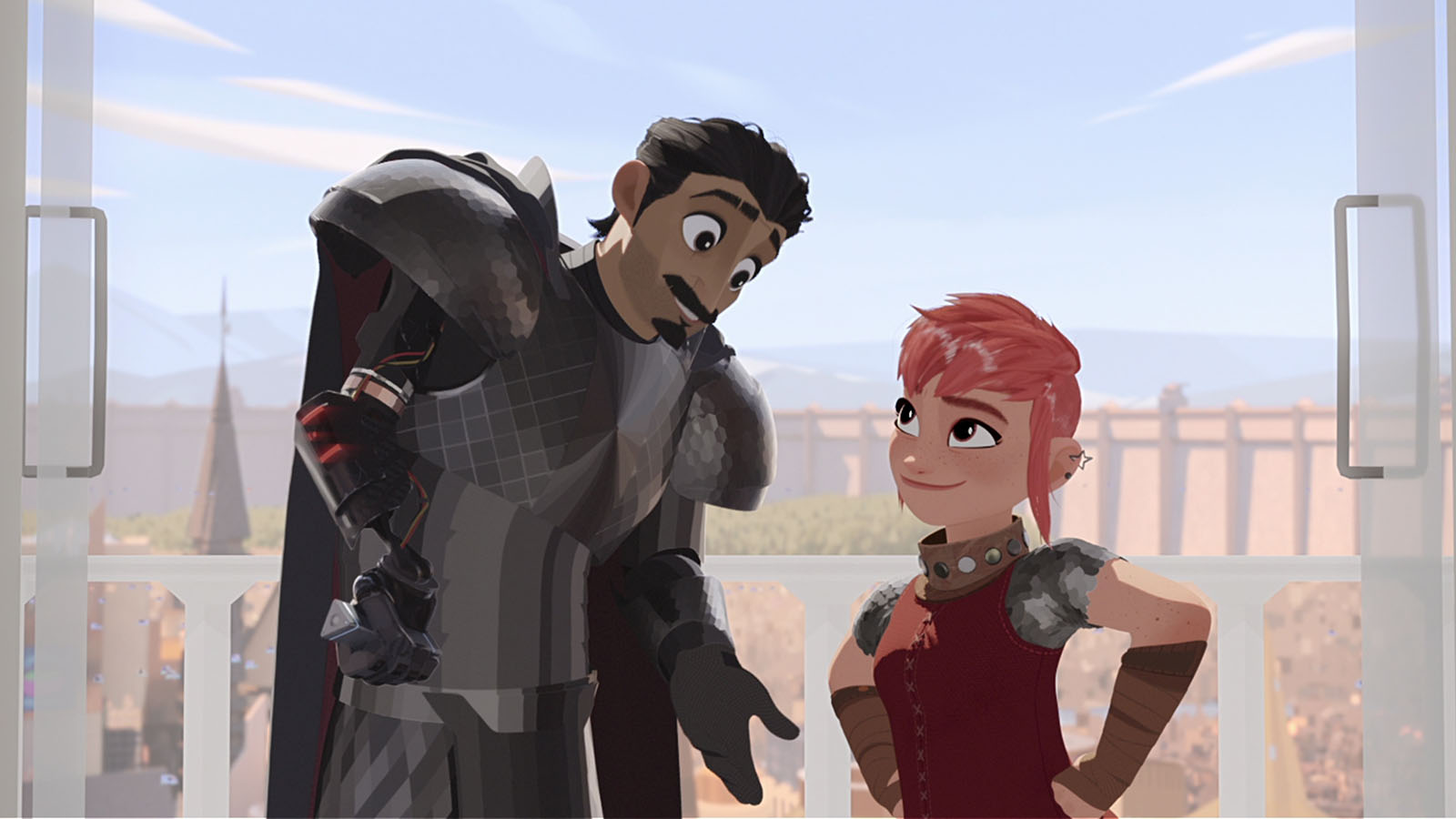
So everyone was all over the place and a lot of those people worked remotely. There were times where people would come together where we would screen certain things or we would want to look at more finished shots for quality-control or timing purposes. If things go on a big screen, the higher resolution looked better, or if we wanted more time on the shots, etc.
But I thought it was really efficient working remotely, particularly for me editorially, because in animation you’re not just editing and sitting with the directors. You’re in tons of meetings all day, whether they’re story meetings, layout meetings, camera meetings, post-production meetings or effects—all these meetings where I’d typically be sitting there imagining all the work that’s waiting for me back in my office and they’re having a conversation about sub-pixels or something. It was great to be able to both be in meetings and then maybe when the conversation didn’t involve me, or when it just went down some rabbit hole, I could turn back and continue cutting and have an ear on the meeting.
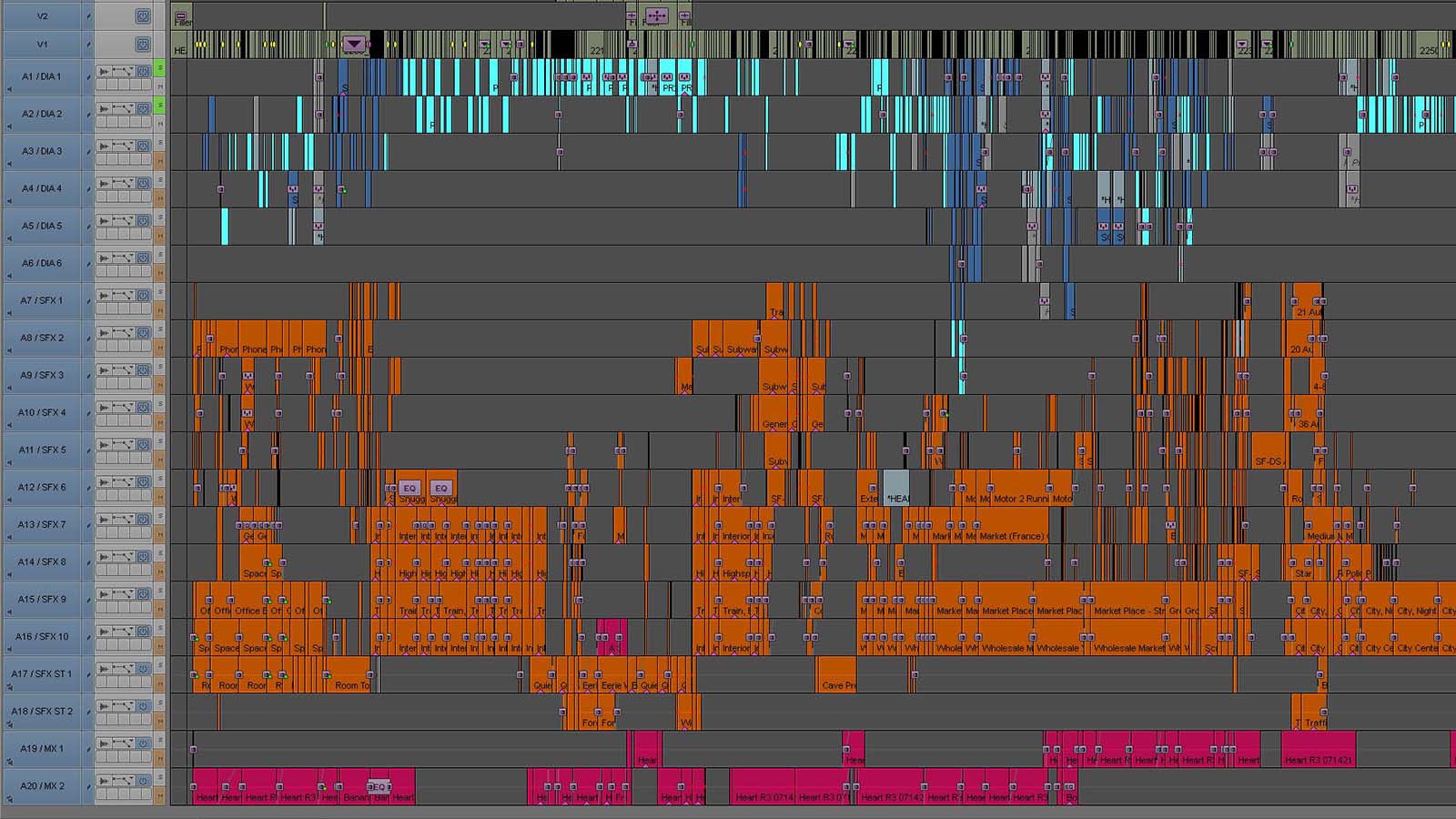
So I found it really efficient to work that way. And I think I only worked with the directors twice in two years in person until we got to London to do post. And then we would do more regular reviews together just because the Avid was there and it was easier to just walk into another room than get on Zoom.
MF: You have a voiceover open, which seems to be more frequent in animation. Voiceover isn’t unique to animation, but it seems more often than not in animation you have voiceover. That made me think about the practical reasons for doing this, whether it’s budgetary or time related or audience oriented. Typically your audience would include kids and this might be a more effective way of setting context or providing exposition than it may be in live action.
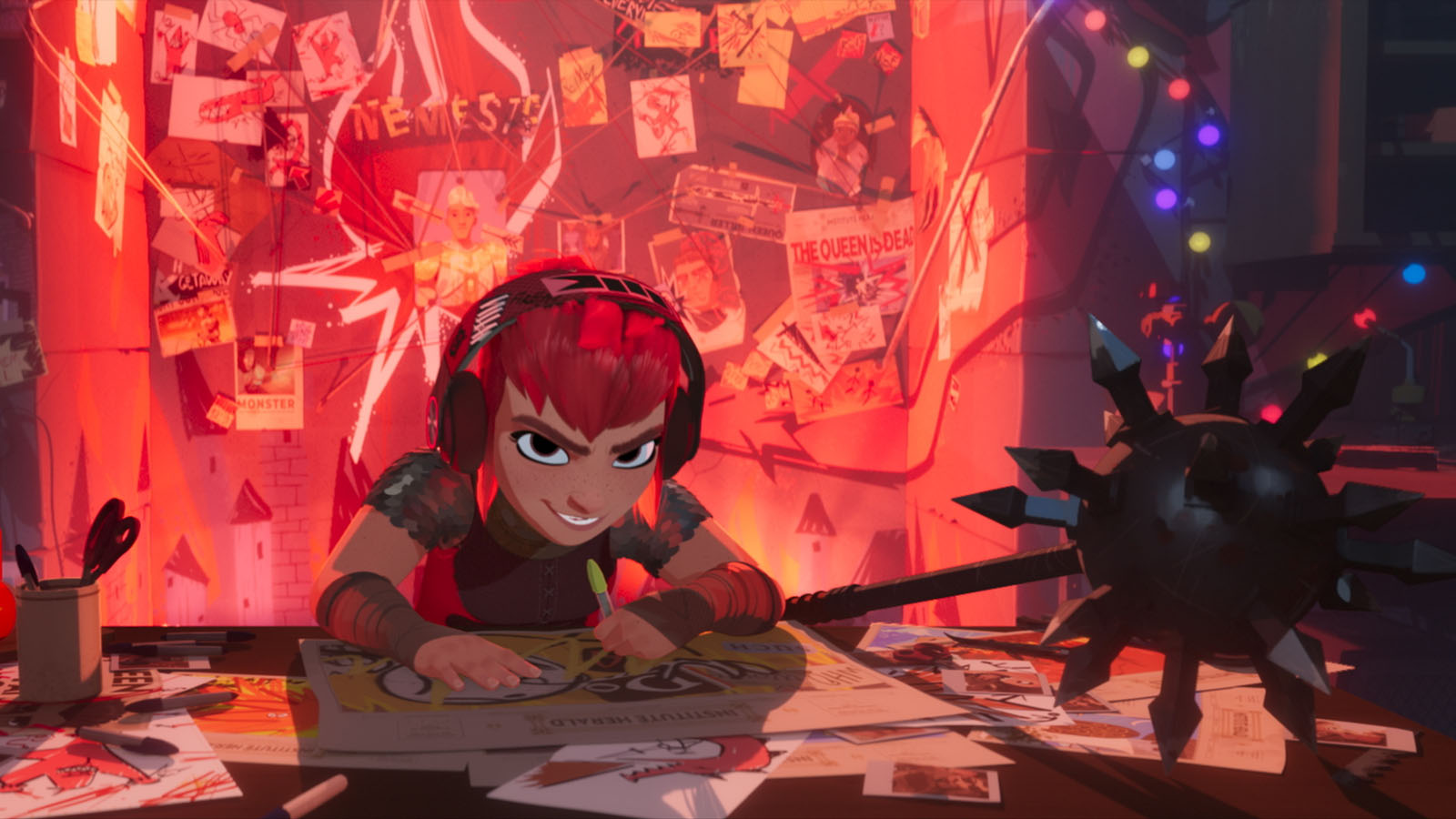
Randy Trager: Yeah, that does seem to be an animation trope in that regard. And that’s a portion of the film that we struggled with a lot. The first act essentially is how much information do we need to put out there and grounding people in this world, which is a world they’ve never seen—this combination of futuristic and medieval—and some of the rules in that kingdom.
It’s not my favorite thing to just have somebody talking. So we worked for a while in streamlining and distilling that first act. We spent more time on that than any other section of the movie, I think. We tried to put it on its ear a little bit by doing a sort of sports highlight reel feel to it, which helped, but was a little too long at one point, as well. I would definitely agree that that seems to be a ‘Let’s set the table for people and give them information.’ Sometimes it’s not necessary, but I will say, at least with this particular movie, that it was always that way from the outset, at least this version where the intention was to use that trope.
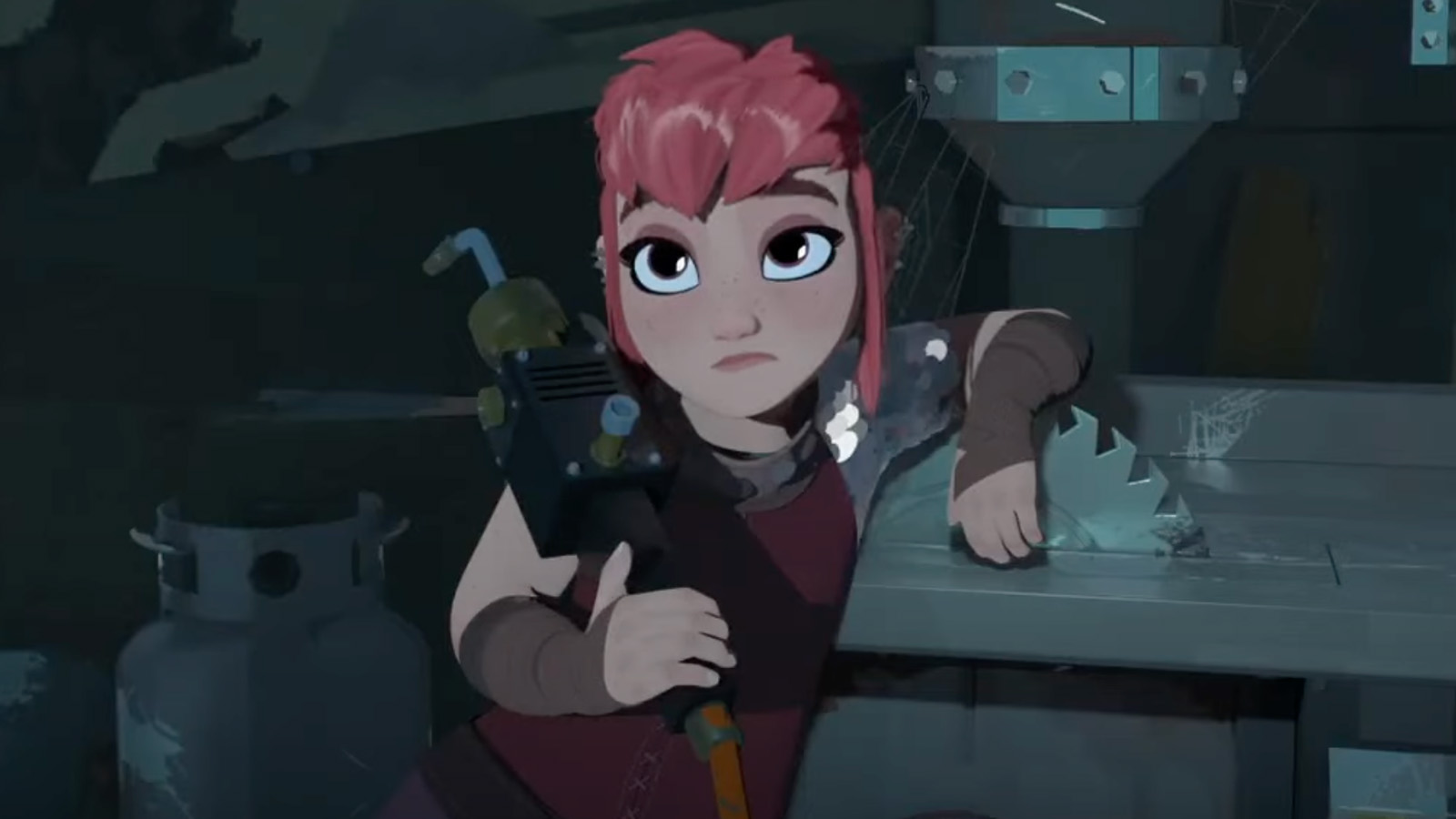
Maybe people would think, ‘Oh, I’m in this fairytale type of framework and it’s a story that somebody is telling and I should believe it because it’s reality.’ But later on, as we find out, that’s not exactly the story. So here it was by design, for sure. It wasn’t any kind of band aid.
MF: What happens after the voiceover is you jump a thousand years into the future and then you have a splashy Hollywood news report kind of piece setting up the whole movie and who this character of Ballister Boldheart is. Up until that point, you don’t get the sense that this is going to be a funny movie, but soon as you get into this new world, it’s funny.
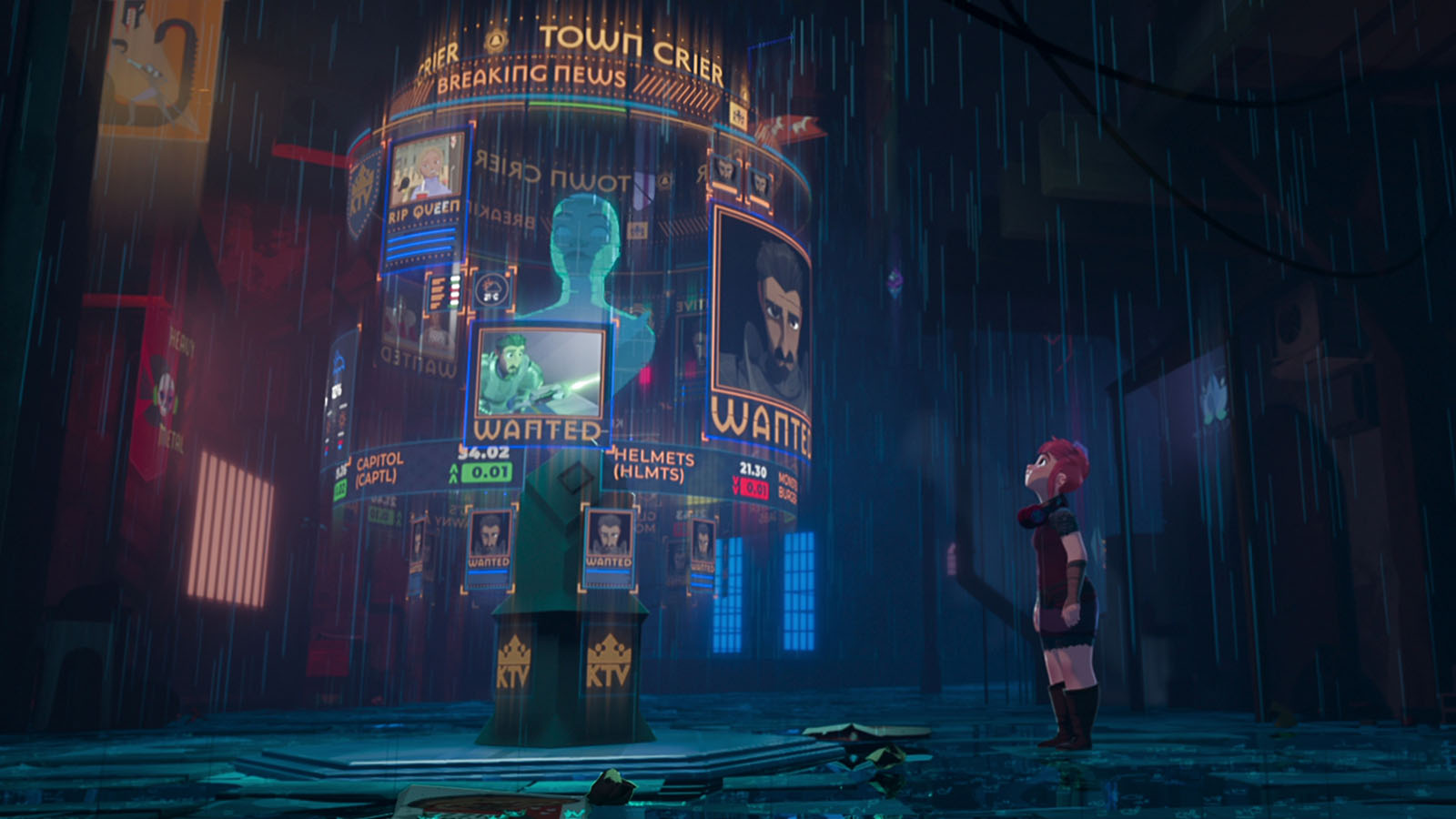
Randy Trager: Yeah. The hardest thing I found to get hold of is the tone. Tone is always a tricky thing, especially when you’re basically starting from scratch and you’re starting with scratch dialogue with non-actors. And the story is one thing in the script, but when it’s boarded it maybe translates to something else. And it’s just this thing that is so intangible to find.
When you find it, you know it, but it’s something you search for, for a while. Lucky for me on this show, there was a lot of tone work and story work that happened over the course of several years. So a lot of that was done way before I even came on.
I think particularly these directors, Nick and Troy, love playing with tone, as well. They love to be able to set the stage and then sort of subvert it. I think we did the same thing pretty successfully in Spies, where it feels like it’s serious or there are characters within that world who take the world very seriously. And then there are other characters who do not at all, and or who bring comedy to the character that’s taking it seriously.
And that, I think, creates a lot of potential for fun and comedy. So I think it was always the case to be able to switch tones a lot in this movie, and Nimona being the character that she is, is able to do that better than anybody in animation.
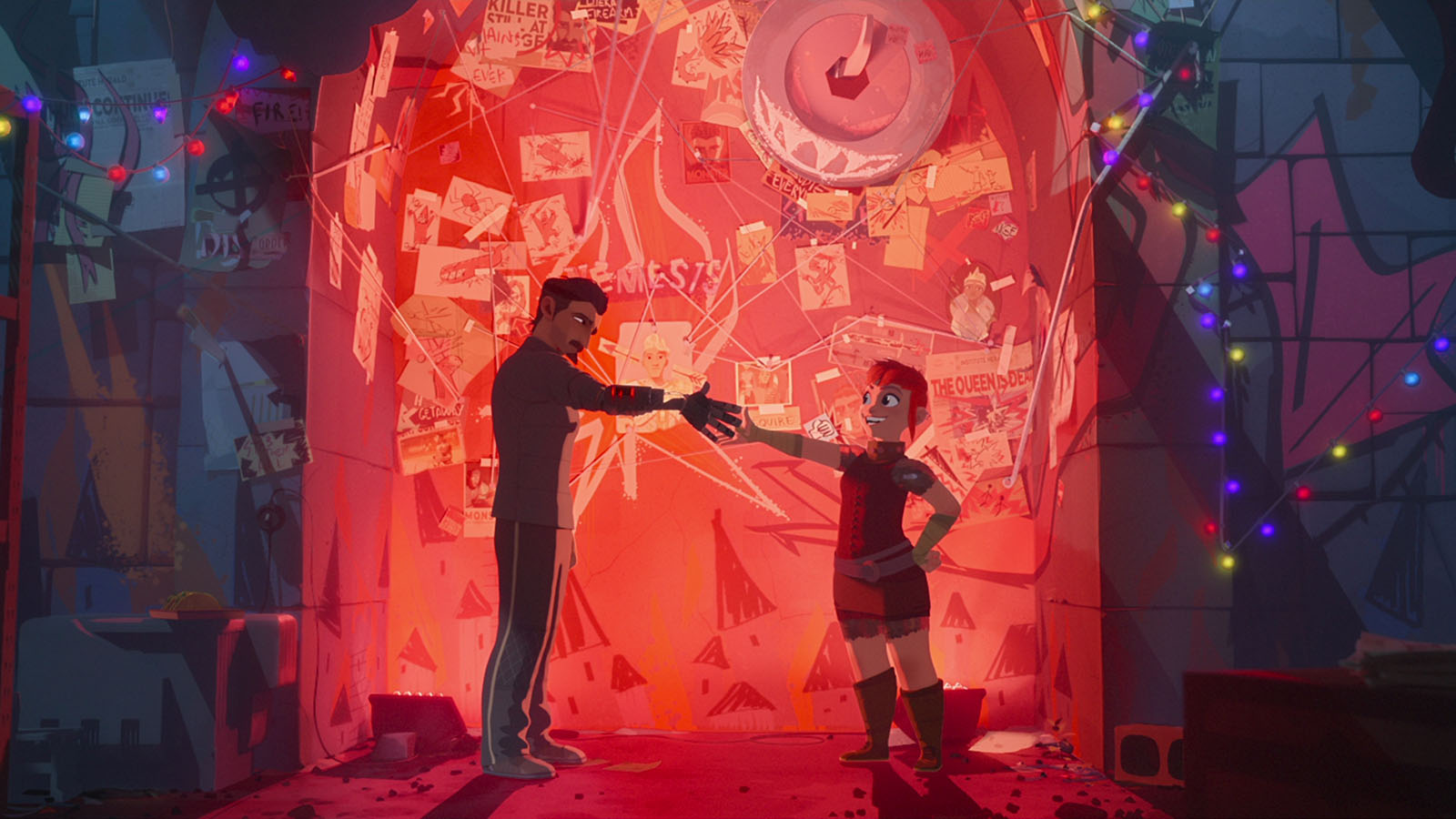

MF: In a film like this you’re trying to send a message, a very important message. Something that has come up before in conversations with editors of comedies where there is a message to be sent is whether the comedy undermines the message. Tell me a little bit about sending the message in a way that’s funny, but also on point.
Randy Trager: Yeah, that’s always a tricky thing and we found that we glean a lot of information about the success when we screen for an audience—they tell us. The meaning behind this movie was really important. The directors were always hyper-focused on not letting the comedy step on that and letting the comedy come from “natural” moments within the film.
At least from my time on this film, we didn’t struggle too much with the comedy getting in the way. There may have been a joke or two later on in the film that was misplaced or misdirected, so we pulled it out. But I think because they were so focused on it the whole time, it was always in a nice balance.
MF: That’s not an easy thing to get right, and I think you guys nailed it in terms of just creating an entertaining film that also really does let the heart of the message resonate with the viewer.
Randy Trager: I’ll take it and I’ll pass it onto the other editor, who’s not here today. Erin Crackel was on the project the longest. I think she was on it for six-and-a-half years. She was the one constant from the very early version to this version. And she’s already on another project and is getting ready for a screening, so unfortunately couldn’t join us.
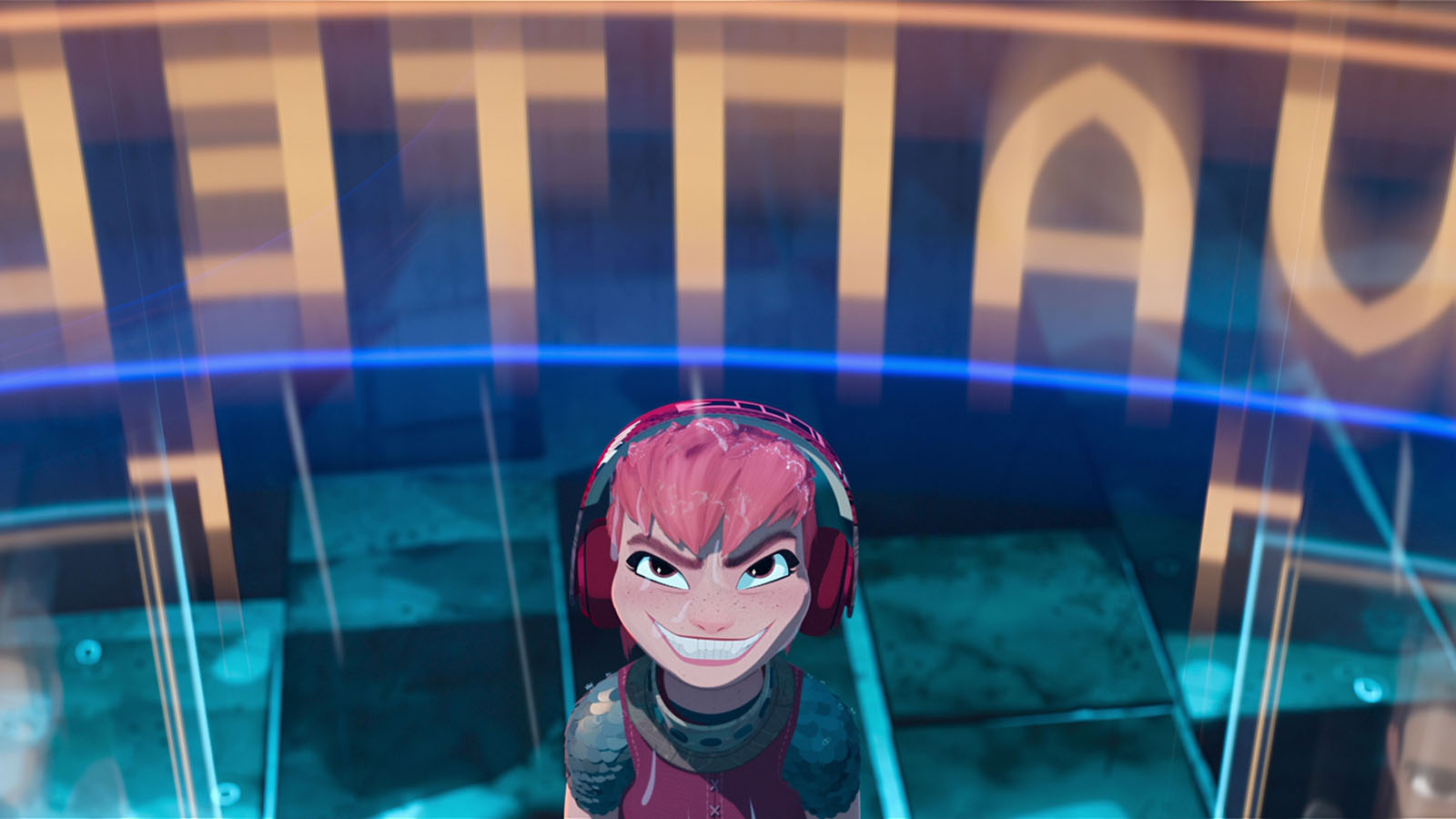
MF: Well, definitely pass along my compliments to her and a pat on the back for staying with any project for six years!
If you wouldn’t mind, I want to go back to some of the technical aspects of doing animation. I know, as an editor, you wouldn’t necessarily think you would have much input into style. But then again, in animation editors seem to be integrated in so many more ways than you would think possible.
Can you tell me about developing the style of animation, and are there established styles in animation? Is there a Disney style, a Pixar style art, a Bluth style of animation—are those recognizable looks that you can talk about as reference points in an animated film?
Randy Trager: I think those styles do exist, particularly with whether it’s Disney, whether it’s 2D or 3D computer generated, and the same thing with Pixar. A film like this from the get go, they had a very specific style that they wanted it to be, which was this combination of 3D high-resolution CG with a 2D layer to it—whether it was 2D shading on a character’s face or on materials, where sometimes you look at a surface on a character and it’s hyper-real, but then you also can look at another element of the same surface and it’s 2D. I think they wanted to keep it still grounded in the look of the graphic novel that it originated from.
In terms of editorially, I think the only real input I have, because I leave that designing and whatnot to those who are way better at it than I am, is maybe sound would come into play at times. Say there’s a sword clank. Is it just a sword clank or is it a sword clank with a hum sounding like a lightsaber?
So those types of things with this movie that either would be suggested to editorial to do or we would say, ‘Oh, well, maybe this could also sound like a motorcycle,’ and those elements would maybe influence the design down the road, at a later point.
MF: You go to great pains to come up with a look for your film, but then sometimes during the film that look changes and I can think of one example. There’s a flashback to Nimona’s childhood. It’s sort of an eight-bit style, which is really cool. But at the same time I could ask, ‘Did you run out of money?’ Because it’s sort of low res. Tell me about just coming to that place.
Animators are always looking to indulge in different styles and combine different styles.
Randy Trager: They knew they wanted it to be stylized because in that case Nimona is telling her back story, but it’s sort of not the real version of her back story. So they wanted to have a sense of artifice, and originally they were talking about graffiti maybe taking over there. I think there’s a little bit of graffiti elements, but then we zoom into the subway tiles and they take on a sort of zoetrope feel with the steel beams that pass when you’re on the subway as it whizzes by.
I think animators are always looking to indulge in different styles and combine different styles. And I think that was a part of it. But I think it really was to serve the story, to make it feel that when we see her story later for real, it’s in a more realistic style compared to the rest of the movie. Whereas this one, since she’s just bullshitting him, they wanted to have a very stylized version of that.
MF: This is something I probably should have followed up on when I was asking you about styles of animation and referencing different studio looks. When we talk about live-action films there are references to other movies. Do you have that in animation?
Randy Trager: Yeah, that does come up a lot. I’d be hard pressed to think of a specific example on this movie, but the directors are always bringing reference points like that up for sure, whether it’s even just the acting. You know, we want the arguing, for example, whether it was with Nimona and Ball, or in Spies, that they would maybe reference other movies where characters are just yelling over each other, talking over each other, cutting each other off.
Sometimes we’ll dig specifically for those shots on YouTube and send them over to the animators or the layout department and say ‘Something along these lines,’ or even sometimes, ‘Exactly this.’ Maybe not on this show, but on other shows sometimes we’d grab a shot or two and say ‘Do this.”
MF: Earlier you talked about making a choice with sword sound effects. Because of the nature of this medium where the visuals are largely baked in by the animators, is there more of an emphasis on audio for you as an editor? Are you putting more thought, more time, more care into the sound design of what you’re doing?
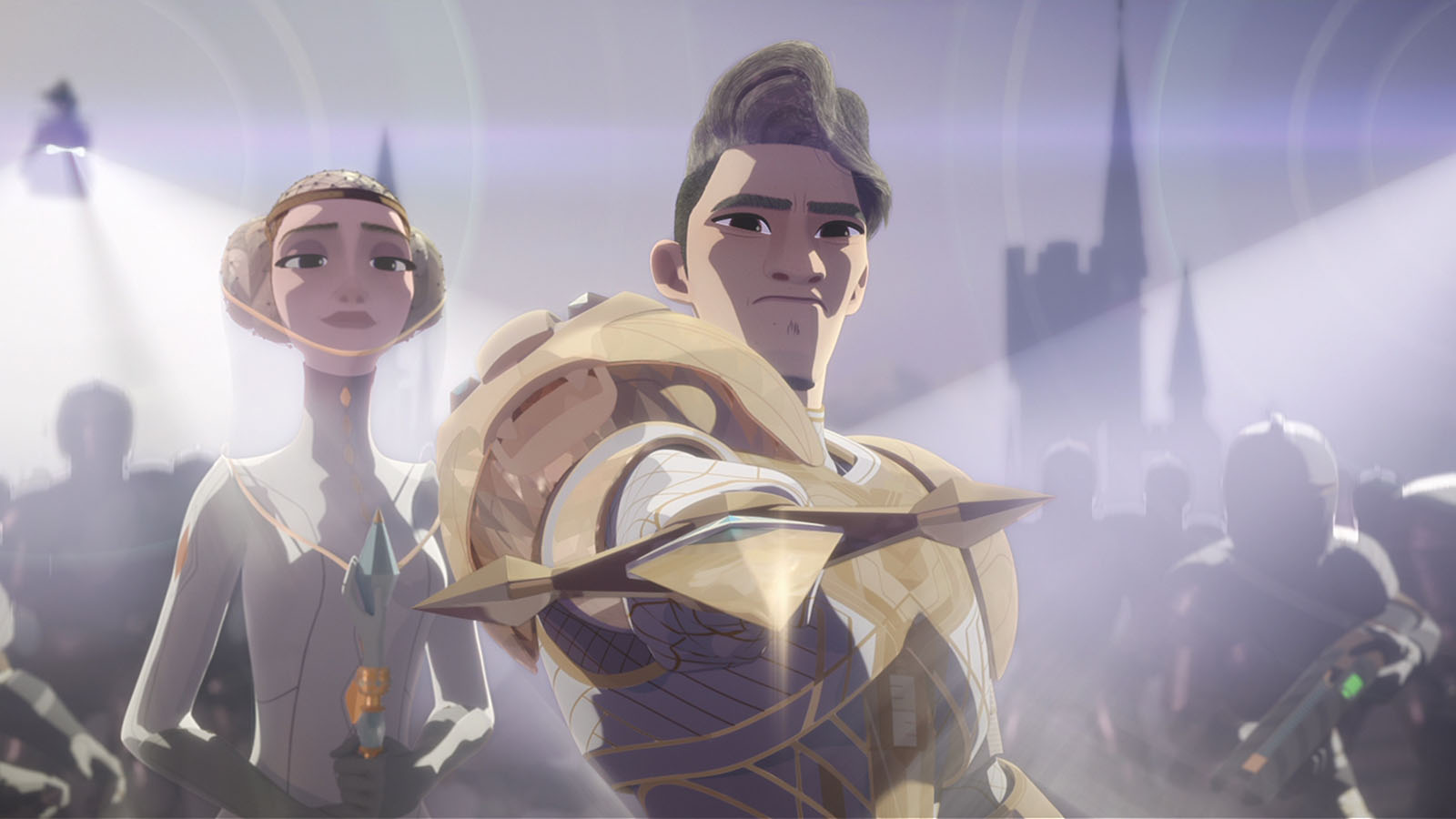
Randy Trager: Yes, Always, always. And in the best version of things, at least from the editorial side, when it’s animated, it would follow the framework that we’ve designed and we try to make it sound as final of a soundscape as possible. When we’re working on these things it’s not just left to chance as to what the animators will do.
Sometimes we’ll find that an animator may need time for the character to do something, and so the sound effects where it lands currently would maybe get in the way of that. Maybe we’d have a door slam over a line, or sometimes it’ll be a little bit of a back and forth in terms of us adjusting or moving things. But yes, we put a great deal of time, energy, and emphasis on having the sound as final as it possibly can be—and then throw it all out when we go to post and have our sound designers do it all over in an even better way.
MF: As much as I understand animation—and that’s not a ton—it seems to me like it’s a very linear process. As you’ve pointed out earlier, there are phases that you have to go through. It’s almost like they’re gated—you can’t get to the next one till you get through this one. You talked about the sound effects and retiming things, and that seems like something you’d be able to do with a lot of freedom throughout the process. Whereas needle drops—in this film we’ve got the “Tra La La” song by the Banana Splits and then you’ve got “Breaking the Law” by Judas Priest, and then you’ve got “Careless Whisper” being played in the subway.

With the needle drops, that does seem to be something where you can’t really change it later on. Or if you do, you have to be very careful about the beats per minute of the song that you’re replacing. Am I way off or is there some truth in any of that?
Randy Trager: No, there’s truth to it. But we’re not always beholden to it, I would say. And it’s hard to be beholden to it when over the lifespan of the movie, the needle drops change. We may have cut a scene to one song and then at the eleventh hour, change it to another and then go back in and have to recut.
So in some instances, depending on the nature of the scene, it would be so ideal to have the song in the beginning, and you cut it to that, and then it’s animated to that. Then again, that can sometimes feel too animated, that everything’s being hit on a certain beat or it’s just too nice and neat. So we do consider that. But at the same time, depending on the circumstances, that will go out the window and you just have to make it work to whatever song it becomes and have a good music editor by your side.
MF: Do you have a hand in any of that? What was the needle drop process on Nimona?
Randy Trager: It’s funny, because when I came on the needle drops were not the ones that were ultimately in the movie—not all of them, but many of them. And I was told by the producer that, ‘Yeah, we’ve cleared everything and this is how it’s going to be and everything is locked.’ But I should have known that with this crew, they’re always going to try to find something that’s even better or funnier or more appropriate.
And so over the course of the movie, every needle drop that’s in there represents probably five or six that were not in there at one point. So they’re chosen, by and large, by the directors, at least in conversation. I mean, there’ll be times with people just getting out their iPhones and just hitting the spacebar and they’re holding their phone up and it’s playing along. And we’ll think, ‘That’ll work. Why don’t we get that and drop that in?’
We tried so many things, particularly where the Judas Priest song is. I think Bon Jovi’s “Wanted Dead or Alive” was in there for a long time, which I think to a degree, from my perspective, took me out of the movie a little bit. It felt so familiar and so from our world. And I guess “Careless Whisper” is kind of that, too, because it’s so identifiable. But the fact that a busker’s doing it maybe makes it okay as a needle drop. The Bon Jovi song was also too expensive. So we looked for an alternative and for a while we couldn’t find anything. And then our music supervisor suggested that one and we played it. Right away we thought ‘That’s even better than what we had in there.’ That was a nice surprise when they sent that over.

MF: Again, with it being animated and somebody is manifesting the images within the Avid, do you bother to even do any sort of retiming or comping of anything? Or is it more that anything you do is temp and then somebody is going to go back and reanimate what you did? How does that process work?
Randy Trager: Yeah, we do a ton of comping when it’s in storyboards for sure, whether it’s drawing smiley faces on people or having eyes look one way or another. Or flopping shots or taking a character from another shot and putting them in a shot that they never were in. So we do tons of comping like that. In terms of retiming shots, when it goes to layout where the first 3D CG camera is placed, we will go in and retime things there. Whether it’s a camera move, if the camera move was too slow or fast or vice versa, we’ll manipulate it that way.
Or sometimes we’ll speed up a character’s movement. When we get to animation, we may get more granular. If there’s maybe too much business that the animator added, we’ll just cut it out. Maybe a character walked around the chair three times before they sat down and we’ll just cut to them sitting down. It’ll look like a bad edit, but we’ll send it back to animation and they’ll retime it and clean it up and send it back. So we do have a hand in the timing of things, for sure.

MF: Again, I’m not an expert on animation—I think everyone’s figured that out by now—but I’ve been introduced to a term that’s new to me: sequence-itis. I think that was from the book Making the Cut at Pixar that we covered on the podcast a while ago.
And I’m quoting here: It’s a condition of working on a sequence or a scene to the exclusion of the rest of the movie. Way too much time is spent on one scene without stepping back. In live action, scenes are shot by locations. Every time you change locations, you have a new scene. In animation, each sequence is a little movie unto itself. So when you put the movie up, sometimes it feels like there are lots of mini-movies instead of like a cohesive film.
Does the term “sequence-itis” resonate with you at all?
Randy Trager: Yeah, for sure. A lot of people in editorial that I’ve worked with try to show early, show often, and show a lot. Sometimes if I have a scene and there’s a rough version of the scene that comes before it and maybe an even rougher version of the scene after, the more we can show in context, the better.
Because I think something that happens with the sequence-itis thing is, as you said, it becomes a mini-movie of its own where it should have a beginning and a middle and an end, whereas a lot of scenes don’t need beginnings or ends. They just need the meat, and you have better propulsion that way. So a lot of times when we do put these things together for the first time, that becomes pretty apparent.
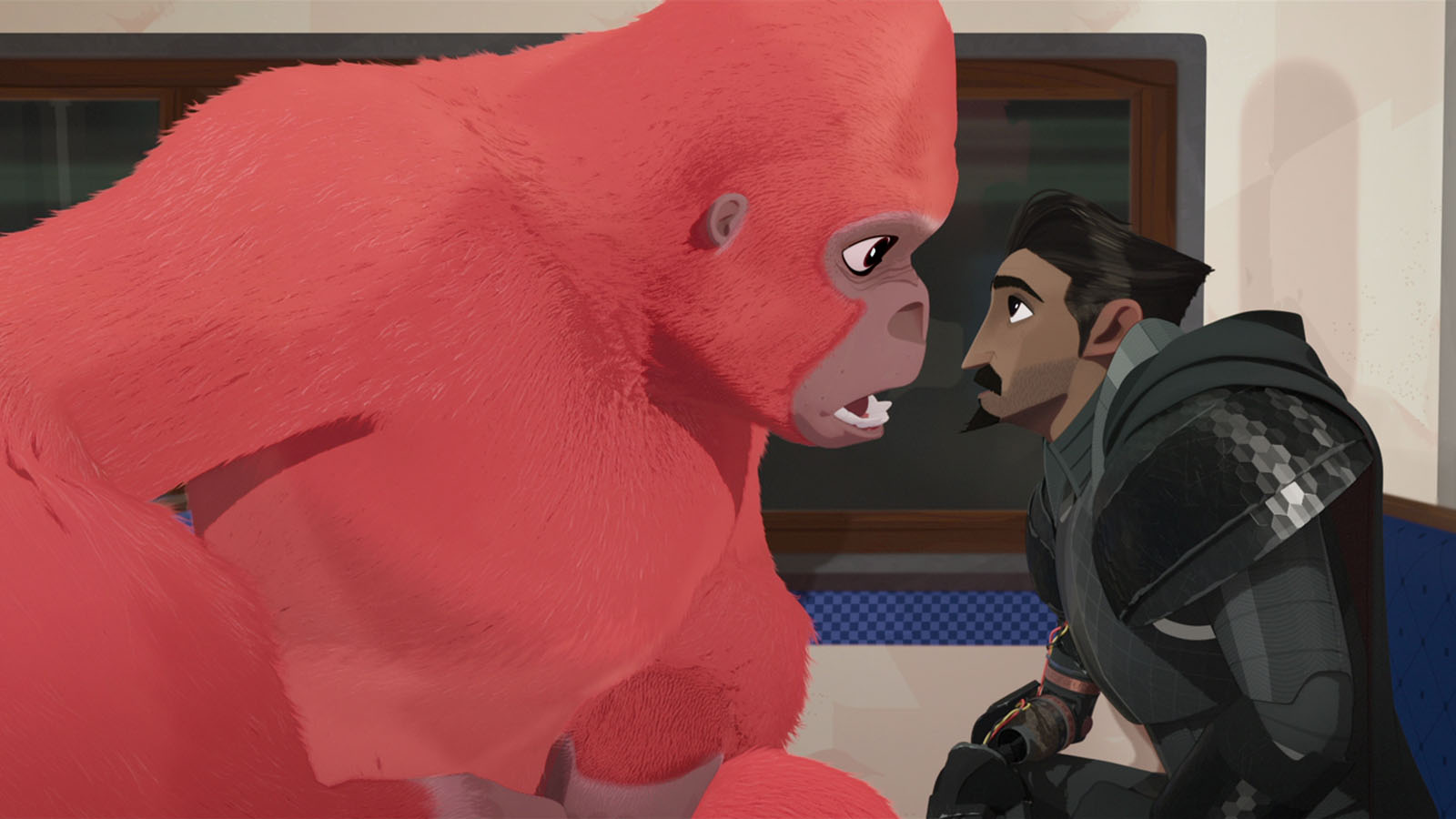
Every sequence feels like a reset. It’s like you’re setting the table and then steps one through four where you can come in on a scene on three and get out halfway through four, or maybe not even need the scene. So we really take effort to fight against that and watch as much as possible in context.
MF: Let’s talk a little bit about your assistants. The role of the assistant may differ from animation to what that role is in live action.
Randy Trager: I would say there are more similarities than differences. Our first assistant was Steve Schwartz and our second assistant was Ashley Kai. And then there was a crew of Blue Sky assistants who were too many to name, but we loved them all. The assistants’ job is communication and dissemination of information, if that doesn’t sound too boring and technical, to other departments. Making sure that other departments have the right version of a cut, which is essential because it’s so wasteful for them to be working on an outdated cut.
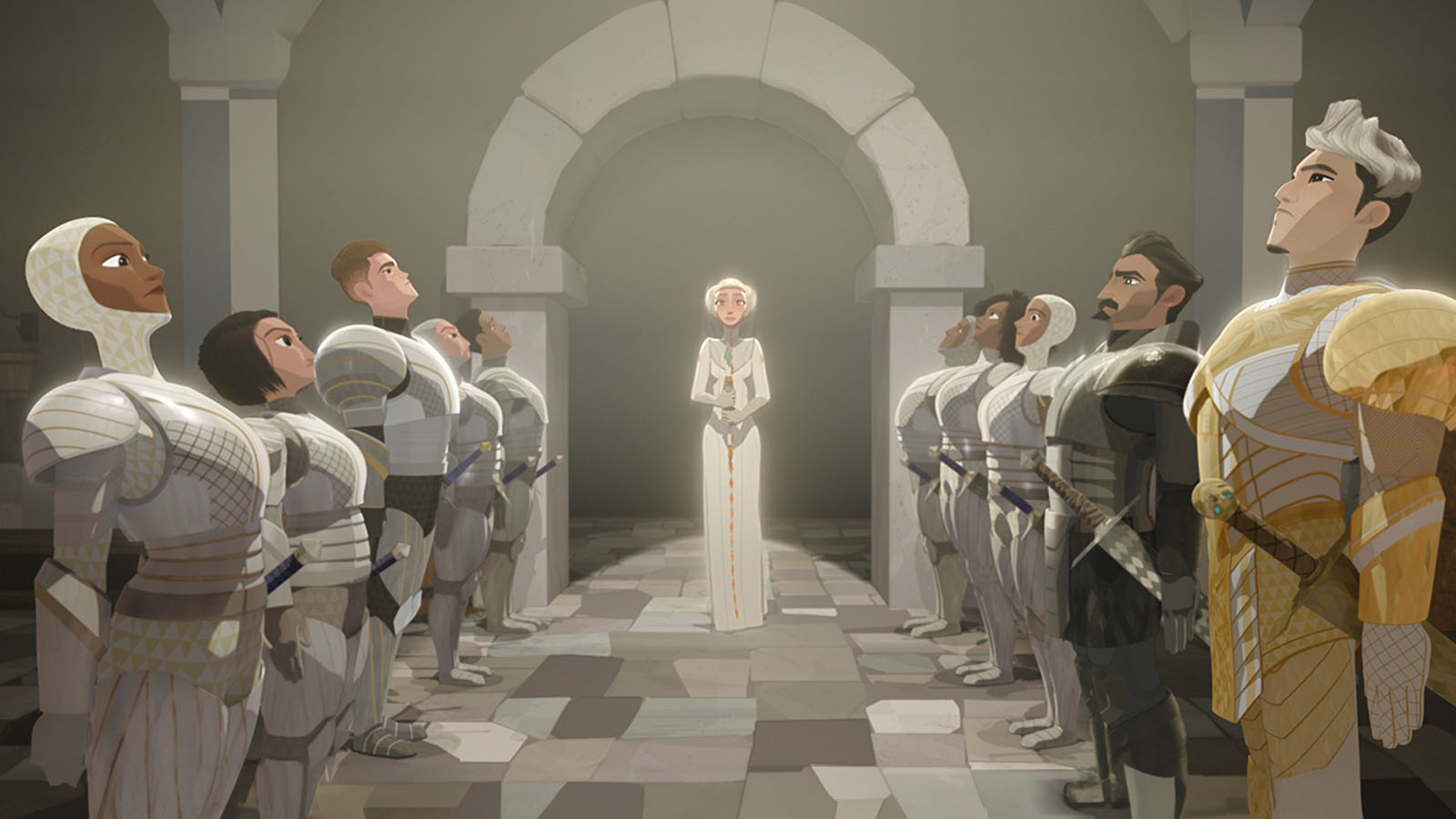
And that could also mean if I go in and make a six-frame change on a shot and those frames don’t exist, it’s their responsibility to make sure that the other departments are aware of that. On this show, particularly, there would probably normally be a visual effects department, which was our editorial staff at DNEG, so they worked with us to organize and disseminate and ingest shots and export cuts. They were connected to our Nexis. So it was really convenient that they could just reach in and grab sequences and do what they needed to do with them.
MF: In looking through the credits, I also noticed there were credits for animation editor and assistant animation editor. What are those roles in comparison to editor and assistant editor?
Randy Trager: On a live-action show that role would be our visual effects editors. DNEG had an editor, Leslie, and she was the animation editor, and then she had a bunch of assistants. I’m not exactly sure what the division of labor was there because it seems like they all had a hand in doing all the work. We would get 100 shots a day, and that’s pretty time consuming for them to get them all cut in correctly.

MF: There is a nod to Blue Sky Studios in the credits. It just said Blue Sky Studios and everybody’s name. And your name was in there without really calling out roles and responsibilities. Was that just a tribute to the former team? What was the idea of having that Blue Sky Studio credit in the end credits?
Randy Trager: I think it was twofold. I think one was definitely a tribute and I can remember the first time seeing it, and it was pretty emotional to see all those names. There are all these people you’ve known for years and maybe you’ve just known them in passing, but you’ve known them for so long that you’re so familiar with them.
So I think that was a big part of it. And then I think also it was a way of crediting anyone and everyone who was involved in the film during its lifetime at Blue Sky—to have a sort of ‘one size fits all’ credit as opposed to figuring out specifically who did what, when, and for how long, and how that compared to some people working on the movie after it left Blue Sky. But I’m glad they did that. That was a really nice thing.
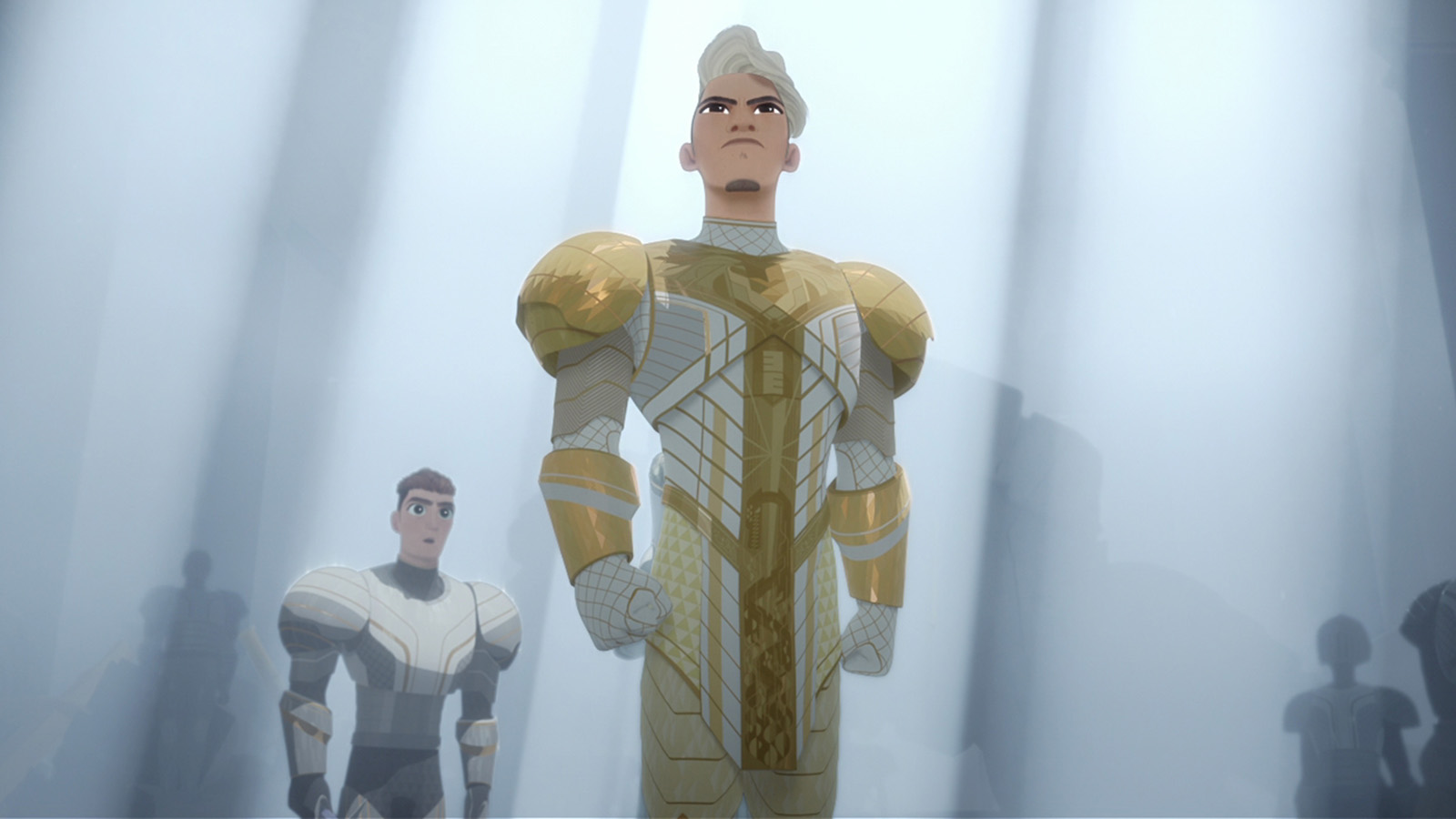
MF: Do you have a favorite part of the process of editing animation?
Randy Trager: There’s a lot, but I feel like my favorite part is particularly after we’ve screened the movie, either for execs or for an audience, where you get feedback and notes. Sometimes they’re nebulous and sometimes they’re specific, but you couldn’t possibly do what the note specifically is.
So I like the problem-solving aspect of sitting down with the reels and, just, the movie’s too long. ‘How can we make it shorter?’ Or, ‘We’ve beaten this idea over the head so many times, where can we pull it out?’ Those types of things where your creativity comes into play. I find that to be a lot of fun. Or just taking a scene and if I feel things are too long—which I always seem to feel—I love playing the ‘Did you miss it?’ game where you lift stuff from a scene, play it for the directors, and they’re like, ‘What did you do?’ and it’s a minute and a half shorter.
I love playing the ‘Did you miss it?’ game where you lift stuff from a scene.
Sometimes I start listing the things that I did cut out. They’re like, ‘Oh, no, no, no, you’ve got to put that back.’ But generally speaking, when they don’t miss it, that’s great. There are so many enjoyable aspects for sure.
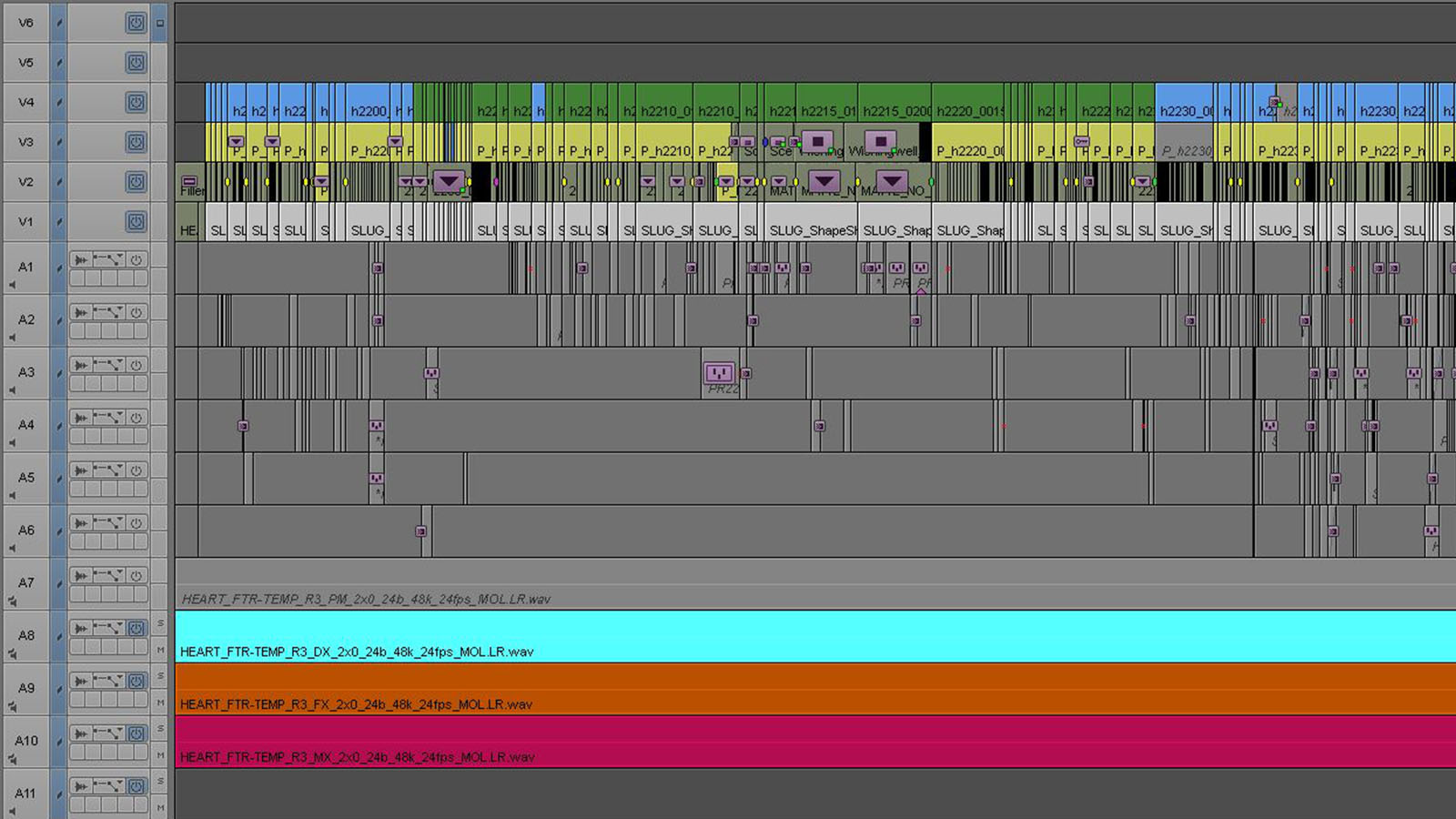
MF: In animation, it seems like the jump from editor to director isn’t as big a jump as it might be in live action. Do you have any interest in directing animation?
Randy Trager: I would say yes. And I think you’re right. We are so close to every aspect. Animation is a case where we’re on set all the time. We’re in all these meetings where things are being shot and created. So we have a really good vantage point. I’d be curious to possibly at least co-direct something at some point. You feel that way sometimes when you’re working [as an editor] that you are a sort of poor man’s director, where you make suggestions that probably in live action wouldn’t be that welcome.

But when you’re working with nice open people and it’s a safe space, you can do that. So it isn’t that far of a leap, I don’t think.
MF: Well, you might be a poor man’s director, but like a lot of editors in animation, you’re a first-class voiceover artist. If you look closely at the credits, you’ll see the name Trager show up a few times. Your voice is credited to Sir Randall Editus. I think that’s the best handle ever given to an editor. Tell me about that.
Randy Trager: I was able to make up that character name at the end when they said, ‘What do you want your character to be called?’ And I thought that was about the most appropriate and stupidest name I could come up with. I mean, it’s always been the case that because we’re just there and we know what we need or want, editors will always record themselves to put themselves in, not as a, you know, for a payday, but we need somebody to say a line and we’re the closest to the mic. So we just do it.
And so I’m sure I was in there three times the amount that I ultimately was in there and thankfully they removed a lot of it. And my kids are, as well. Again, it’s like ‘Who’s around?’ And I’m working from home and I have this microphone and we need a kid. So I grab a blanket, throw it over the mic and throw my kid under there and voilà.
MF: Well, I have to say, Randy, it’s a real testament to you and the team at Blue Sky that Nimona lived on. Ultimately, and thanks to Netflix, people are going to be able to see it. And the only other thing I’ll say is I have a microphone, too. If you ever need an extra voice, just give me a call.
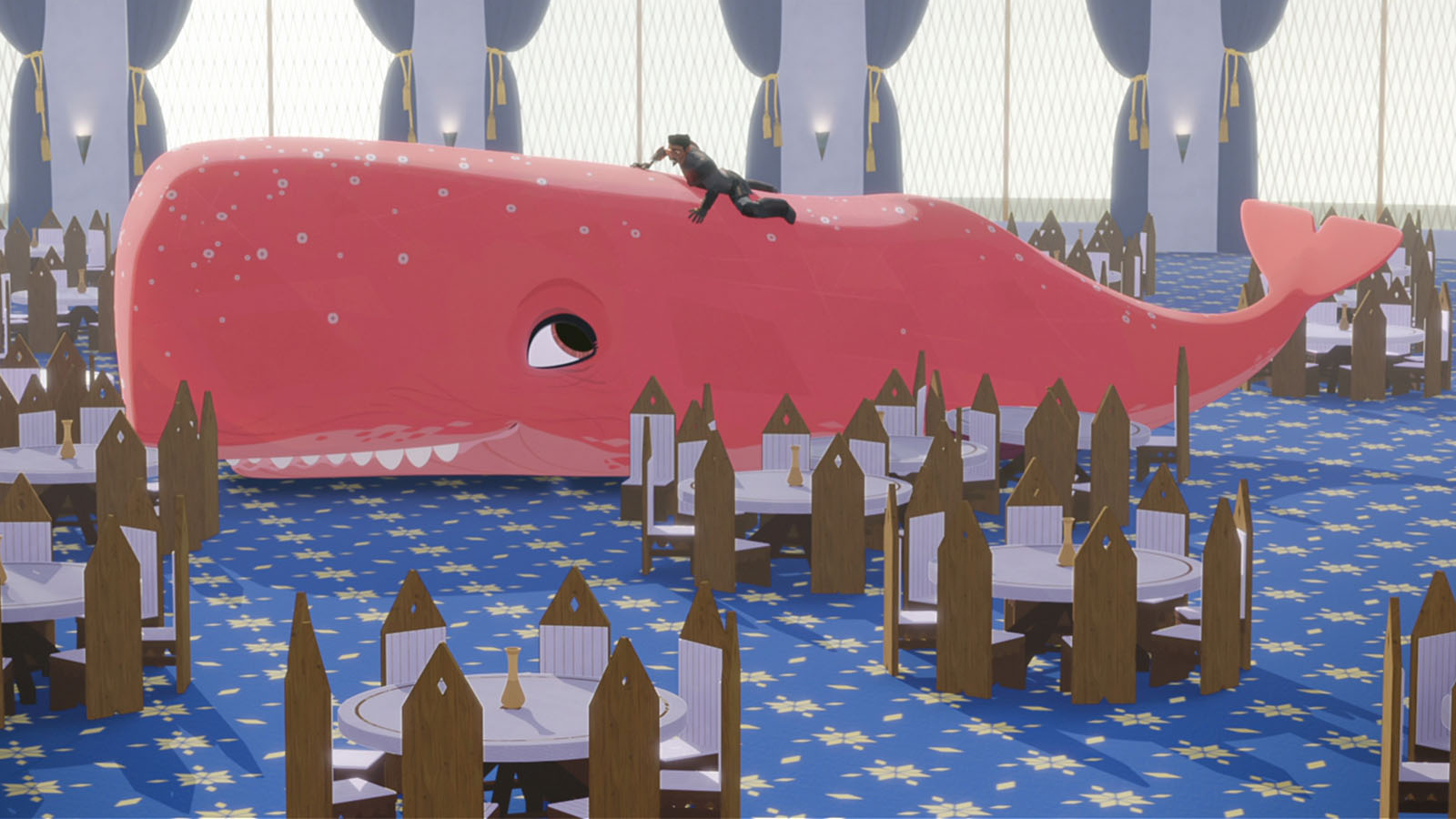
Randy Trager: Oh, yeah. No, you’ll be the first.
MF: They all say that.
Randy Trager: Yeah, I’m not just saying it. Speaking of your voice, I know other people have thanked you because I’ve heard it on the podcast, but I love the podcast. It’s great and it’s great when you’re home working remotely and I’m not interacting with other editors or hearing how other people do things.
It’s nice to listen to your podcast and get a sense of that and the little tips, or tricks or just the commiseration. When I hear people talking about some of the same struggles that we go through because, you know, we’re working in a vacuum here. So it’s, I think, providing a mental health service unintentionally.
MF: Now, I’m going to freeze up on the mic. Thanks, Randy.

